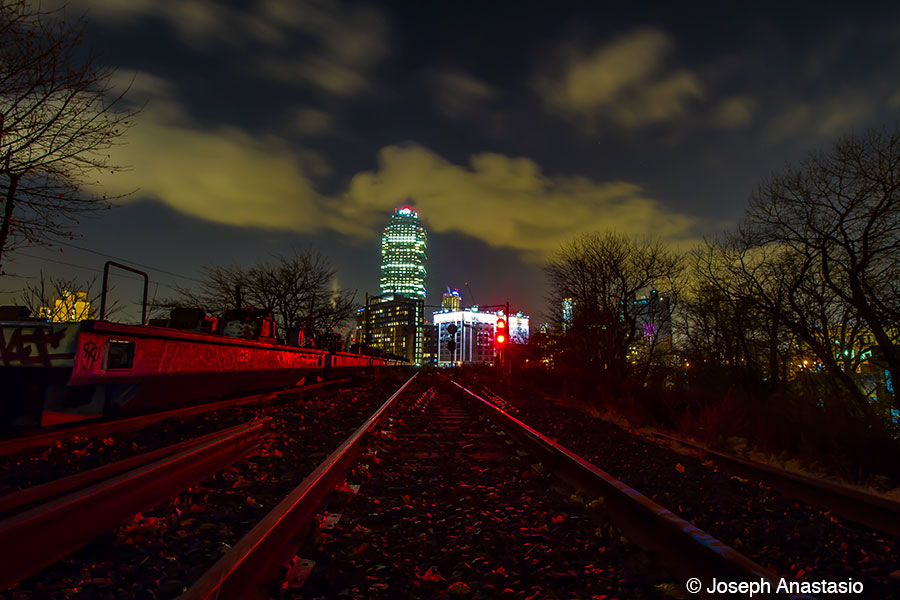
There has been a ton of talk lately about what will become of the Montauk Cutoff. While the future remains unknown, its past is surprisingly more interesting than has thus far been reported.
Before I get into the history, a word about the photos in this post. There have been two blog posts about these tracks in recent weeks, one featuring daylight photos, and another using some photos at dawn. Seeing these, I felt compelled to shoot the tracks at night. At night, it’s just you and the feral cats up here. That’s how I like my abandoned areas. Besides, We already posted photos of the cutoff nearly 10 years ago. There are also a few historic photos I’ve pulled from the LTV archive and borrowed from some of my favorite LIRR historians).
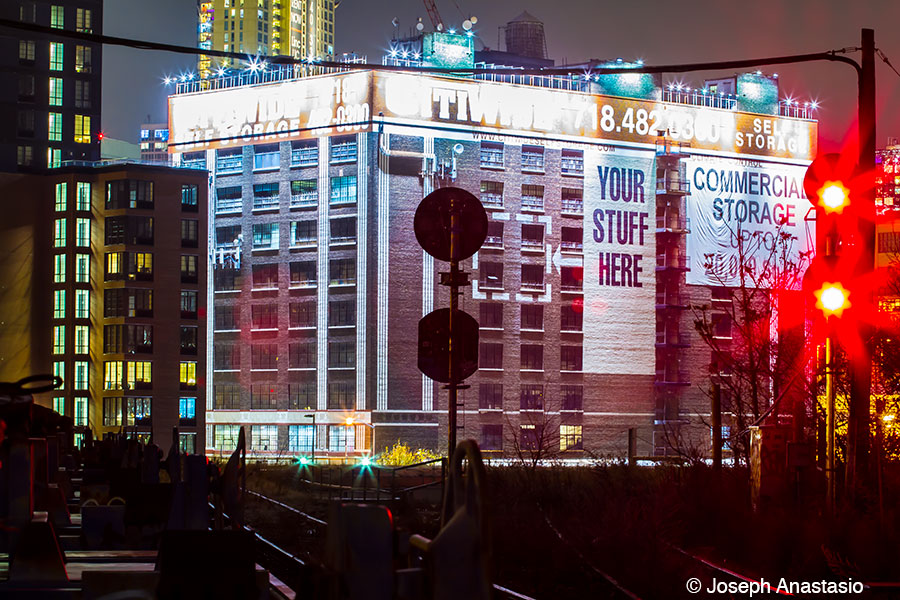
Looking toward Court Square

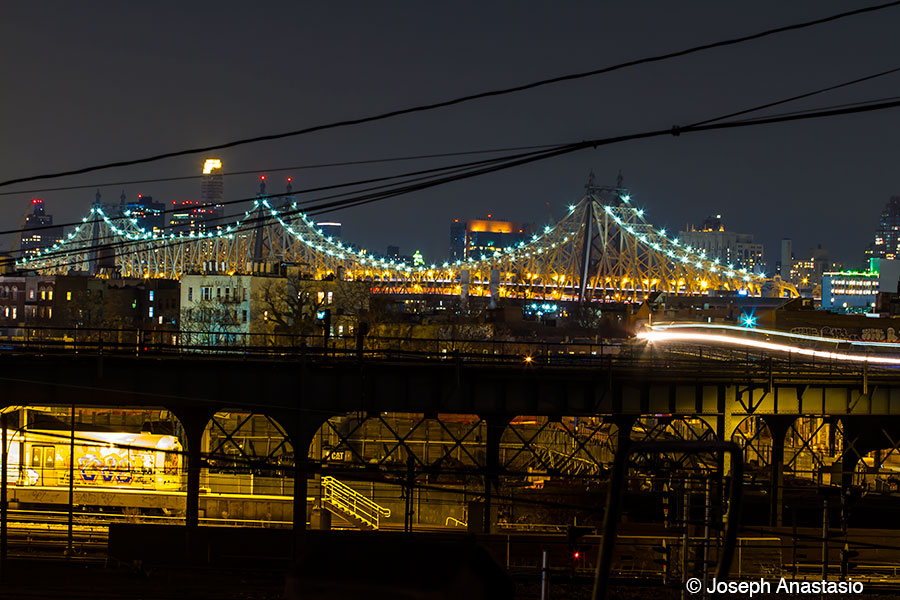
Views of the city skyline from the Skillman avenue end of the cutoff
The Cutoff
Cutoff basics: The montauk cutoff is located in LIC, running between the old ‘Yard A’ and Harold interlocking in Sunnyside Yard, and Blissville yard (near the greenpoint avenue bridge). Here’s a map showing the complete route.
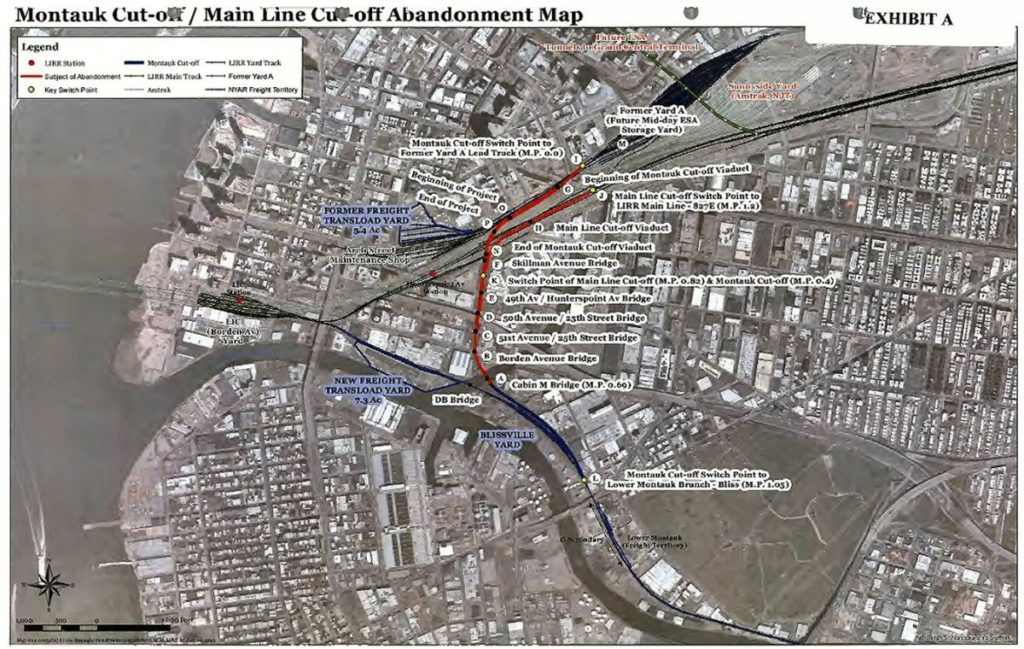
Recently, the MTA put out a request for expressions of interest in turning most of the cutoff (from M cabin bridge, over the Dutch Kills) to Skillman Avenue into a spaced for community use. The MTA will not be selling this portion of the cutoff (also known as a ‘right of way’, or ROW for short). They are merely considering leasing the property for community use, with the stipulation that it can be retaken by the MTA for railroad use (if the need ever arises, more on that later).
Of note, the former cutoff tracks east of M cabin bridge are actively used as part of Blissville yard, where Waste Management has a 20 year agreement to haul trash out of NYC via rail car.
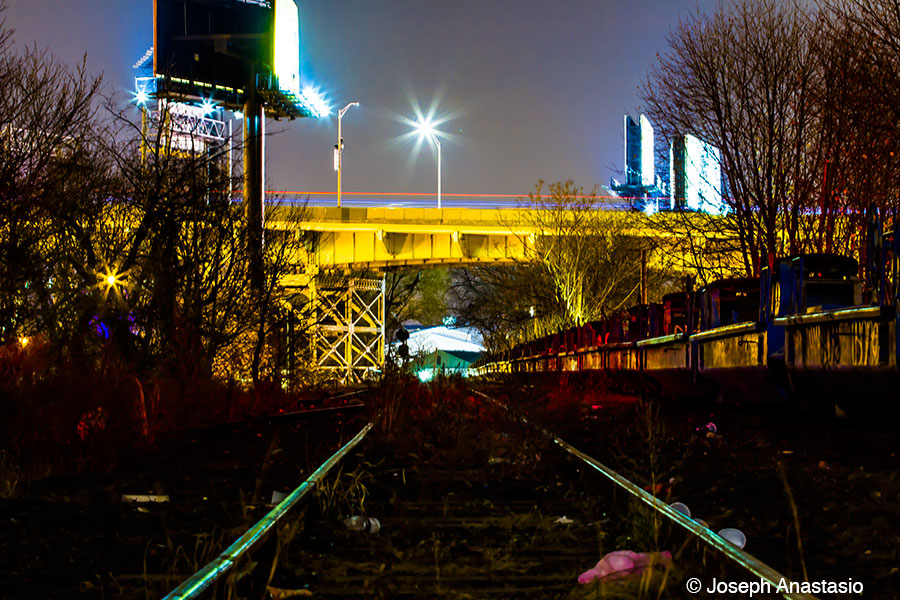
Looking south

Original LIRR position signal still lit and in place

The bogies at Hunterspoint avenue overpass
History
The montauk cutoff was built in 1908. Over at Arrt’s archive, there’s a blueprinting showing it as being built in 1908. This date also corresponds to the date stamped in the cement under the overpasses on the cutoff (this is a pretty common year on many LIRR overpasses throughout Queens – imagine the fevered pitch of such rail construction work at the time). Additionally, the ironwork on the spans feature a semi-hidden builders plate stamped “American Bridge Company of New York, 1908” (The American bridge company was formed by JP Morgan in 1900 and still exists today).

1908 date under Hunterspoint Avenue overpass
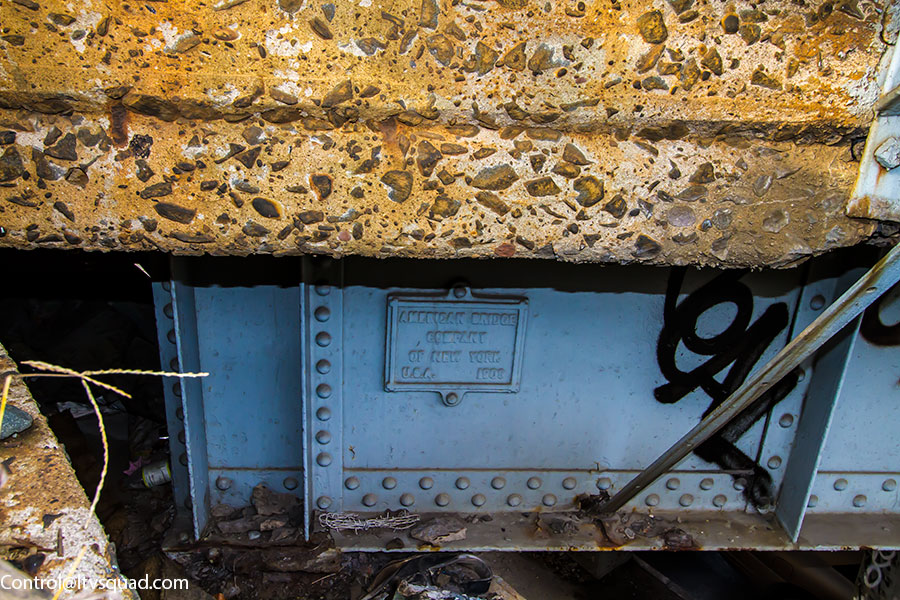
Builders plate on as seen on one of the overpasses.
There were never any railroad sidings along the Cutoff. The fact that the tracks are on an embankment would have forced any potential rail customers to build their buildings either with loading docks level with the embankment, or they would have had to construct ramps down to their buildings. This would have produced a steep grade not suitable to dragging heavy freight cars up and down.
Besides, the industries located in this part of LIC were already well served by tracks diverging from other routes. Montauk Steel had a siding off of the lower Montauk tracks – remnants of this siding can still be found behind Fresh Direct on Borden Avenue and along the northern edge of Wheelspur Yard. Industries along 51st avenue were served by street running LIRR tracks known as the ‘Meuer’ sidings. The massive Bloomingdales warehouse (now the NYC Dept of Education) had its own siding from the tracks near the Hunterspoint Avenue LIRR station. And customers north of Hunterspoint avenue were served by the Degnon terminal tracks.
So if it had no customers, what was it used for?
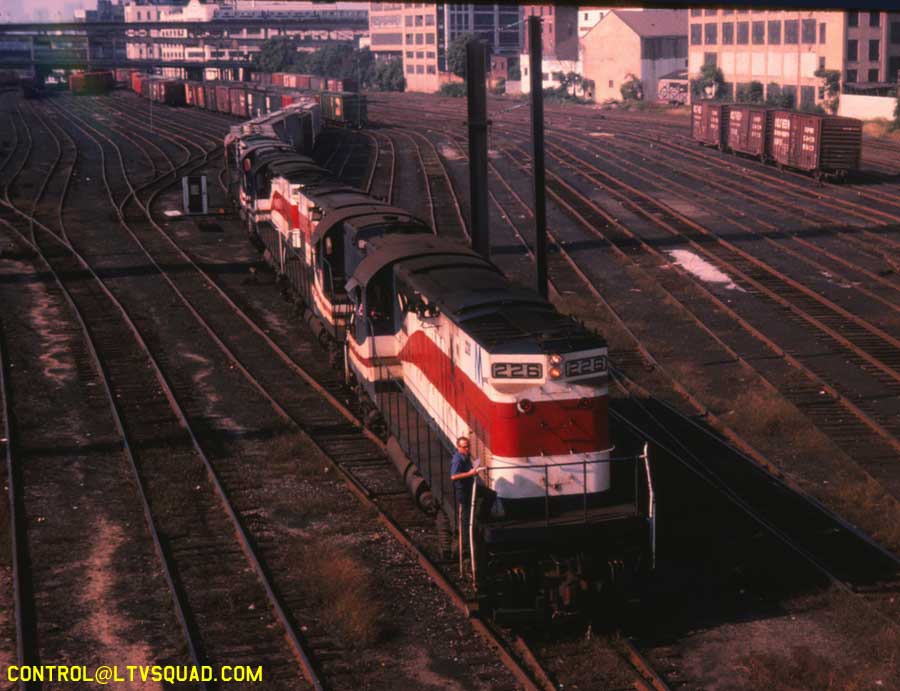
This is a 1982 photo of a long inbound freight LIRR freight train arriving in ‘Yard A’ at sunnyside, as seen from the Honeywell Avenue bridge. You can see the 7 train and CN West factory in the distance. The train is being lead by 4 “C420” freight locomotives built by the American Locomotive Company, located in upstate NY – they’re still painted in a red white & blue paint job applied to many LIRR locomotives in celebration of the 1976 US bicentennial.
The Cutoff was built as a means of getting trains in and out of the massive ‘Yard A’ freight yard formerly at Sunnyside Yard. Today, this yard is being used for the East Side Access project. The cutoff was also used to connect to the Arch street freight yard, the degnon terminal tracks, and a yard on the waterfront where freight cars were barged to New Jersey. This was a very busy route for freight trains. Freight traffic into LIC began to dwindle from the 1970s to the mid 1990s. The degnon terminal sidings (where the current Smiling Hogshead ranch is located) were officially abandoned sometime in the 1980s.
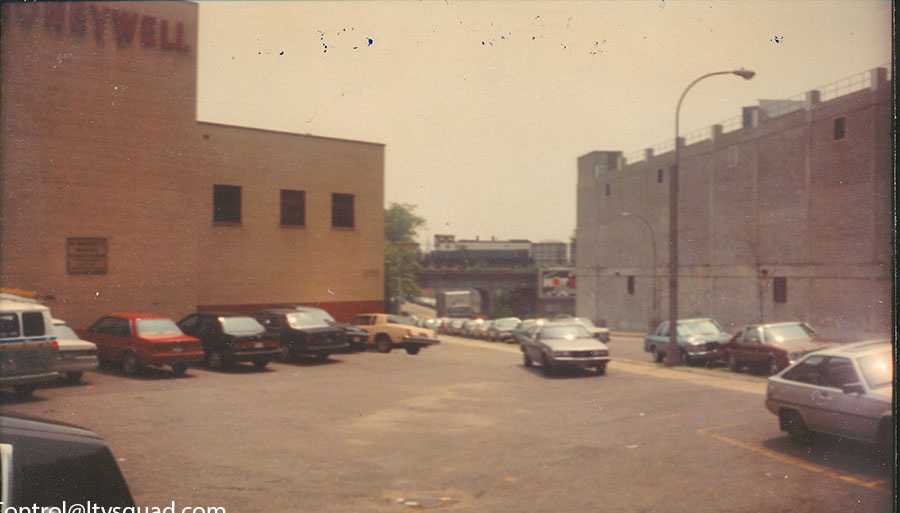
A short LIRR freight train crossing Hunterspoint Avenue on the Cutoff in 1988. Note that there’s a caboose right behind the locomotive – the LIRR regularly used them on freight trains right up until the early 1990s.
By 1996, the LIRR & MTA wanted out of the freight business, and leased their remaining freight train operations to the New York and Atlantic railway (NY&A). NY&A used some of ‘yard A’ for a few years while locomotive shops and tracks were improved at their present base of operations (Fresh pond yard, out in Glendale). By 2002, the only remaining rail customers in LIC were those at Arch street. In 2012 the MTA kicked off a project to relocate these customers to a new, rebuilt Wheelspur yard, located south of Borden avenue. The first customer received cars there in October 2013, and the last customer at Arch street, an oil company, moved to Wheelspur in March of 2015. All 3 have been steady rail freight customers for years. Wheelspur offers more real estate, modernized facilities, and the potential for direct rail-to-maritime transfer of goods.
The turning of locomotives:

A set of LIRR ‘GP-38-2’ locomotives entering the ‘Mainline’ Cutoff at Thomson Avenue in 1989 (Queens blvd is in the background – the mainline cutoff is merely the ramp from the montauk cutoff into Harold interlocking)
For decades, the cutoff was also used every weekday to turn locomotives used on LIRR’s diesel hauled passenger trains into LIC.
For decades, the cutoff was also used every weekday to turn locomotives used on LIRR’s diesel hauled passenger trains into LIC. The locomotives would arrive during the morning rush facing west, and would need to be turned so they could face east and lead their trains back to Long Island during afternoon rush hour. With no turntable in LIC to turn a locomotive (there was one at Wheelspur decades ago), the LIRR would gather every locomotive that needed turning (anywhere between 1 and 7 of them), and back them out of the LIC passenger car yard, through Hunterspoint avenue, and to a point just east of Thomson avenue bridge. Here they would reverse direction again, going onto the Montauk Cutoff, and over to Blissville. Here they would reverse again down the Lower Montauk tracks and into the coach yard – thus being turned around and ready for the evening’s commute (The reverse of this trip would also happen – there didn’t seem to be much rhyme or reason to the route they took day to day).

A string of 5 locomotives running northbound across M cabin drawbridge in the mid 1990s. Note the World Trade Center towers in the background – and the absence of the Greenpoint ‘digester eggs’. Also note the tour bus parking lot on the right (now a cement factory). To the left just out of view is where Seaporcel metals was located.
This practice ended in the late 1990s, after the LIRR bought new locomotives and passenger cars. Some of the passenger cars contain a subway style cab at the rear where engineers can control the the train from.
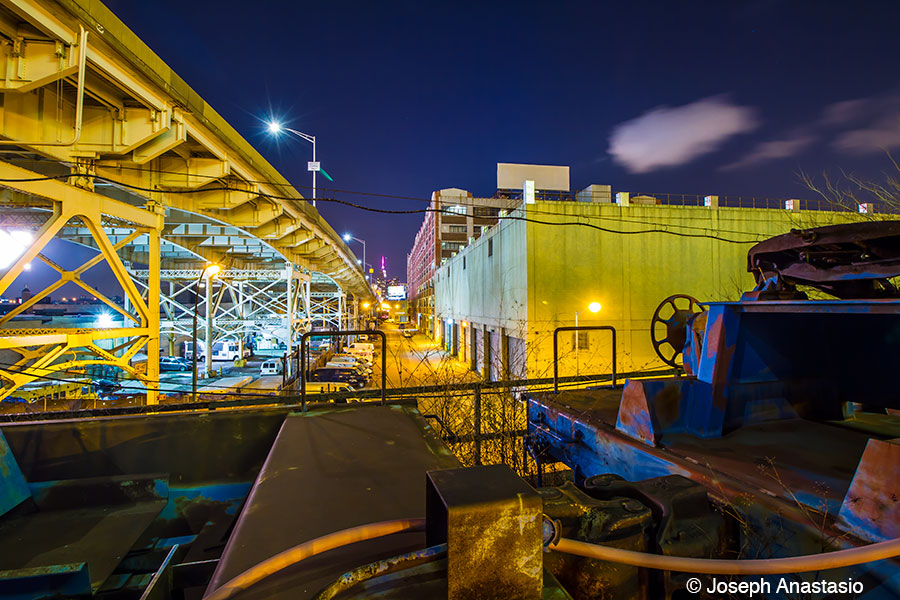
50th avenue

The LIE overpass
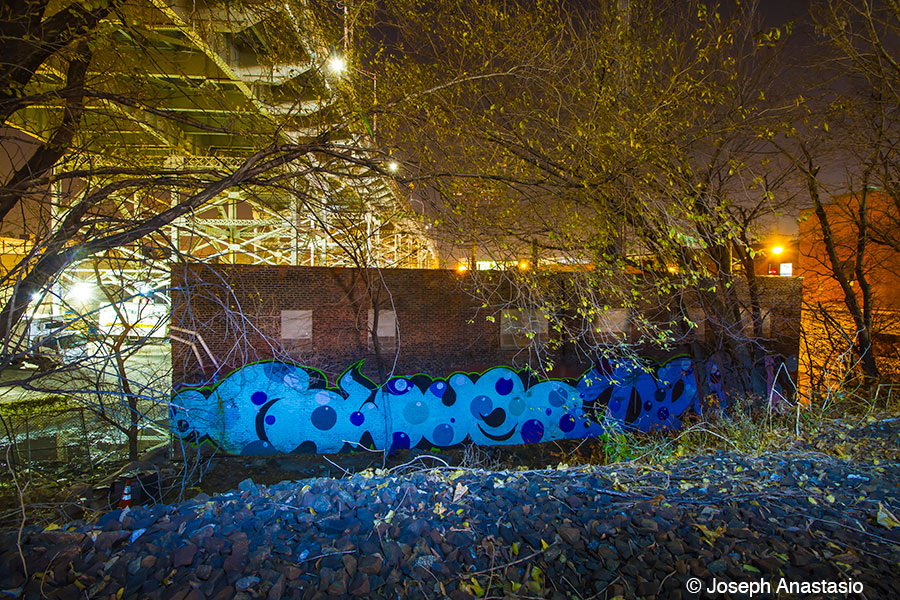
Serious graffiti art near 51st avenue – Looks to be the work of Dek and Glue
With no need to turn locomotives anymore, and no more freight trains, the MTA has found itself with a set of tracks not currently needed.
Thus, when the LIRR filed to ‘abandon’ these tracks, it is indeed a formality: there are no freight customers along these tracks or in the former yards and sidings to the north of it who could petition the FRA (federal railroad administration) for the tracks to remain in service (under federal law, railroads must provide service to any freight customer requesting it that has existing track access).
‘Abandonment’ has a different meaning for railroads: when a railroad abandons a set of tracks, it can retain ownership, to either reuse for trains again in the future, or to resell the property. As an example, Conrail abandoned the High Line. CSX bought Conrail and its property – including the High Line. Thus the powers that be had to negotiate with CSX to donate the route (which likely gave them a large tax write off).

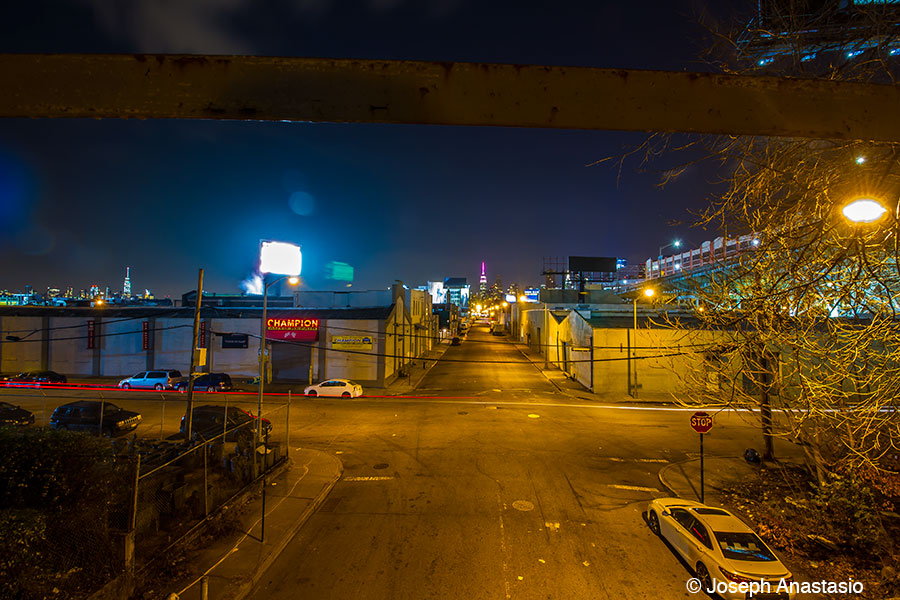
51nd avenue overpass – complete with disgusting light pollution from Fresh Direct’s obnoxious billboard
A word about structures & stability.
The embankment of the cutoff itself is solid, while the tracks were restricted to trains moving at no more than 15 mph. The overpasses, however, have not seen much maintenance and would likely require rehabilitation or complete replacement. The NY&A is completely replacing a similarly aged overpass at Fresh Pond, and repair work on another similar overpass at Woodhaven boulevard cost the MTA $11 Million dollars. The last freight cars to use these tracks had a weight limit of 286,000 pounds – so they’re safe to walk over, but to continue to pound on them with regular train use (be it the 2 or 3 times a week that NY&A used it for freight, or a future commuter rail service using it every few minutes)? Not really a good idea. Rehabilitating these overpasses is an expensive proposition that (believe it or not) the MTA is frugal enough to want to avoid).

Notation on the side of the Hunterspoint Avenue overpass is date stamped for August 1994 – the last time it was painted
So what about that little known history?
Earlier, I alluded to these tracks having some interesting history. In all of the various news bits about these tracks I haven’t seen any mention of this fact: In 1955, the LIRR ran its last steam-powered train across the Montauk Cutoff. It was a passenger excursions – basically an unscheduled, special train usually charter by railfan organizations.
This however was not the last passenger train on these tracks. On January 26, 2014, the NY&A operated a little known ‘caboose hop’. My assumption is that this train was used to show Arch street customers or MTA personnel and politicians, what they were doing with the route. (If anyone knows a bit more about this train, I’d love to add it here, properly credited of course).
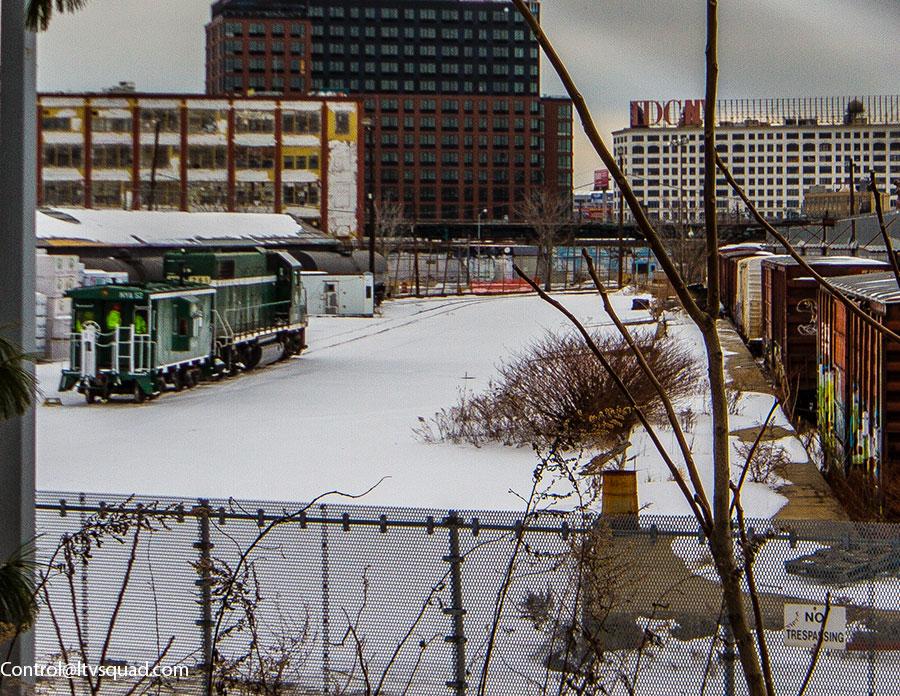
NY&A ‘Caboose hop’ special run seen at Arch street, loading passengers before crossing the montauk cutoff

‘Derail‘ just before Borden avenue bridge

Looking west over Borden, former Montauk Steel warehouses to the left
What about the little blue rail cars?
This is the other fascinating bit of history. The cars are known as ‘Bogies’, and they have been stored on the tracks of the cutoff since the 1990s. We wrote a previous post about these cars in 2006. They may appear to be junk, but what they really are is a failed innovation experiment, with roots in the 1800s when the LIRR was the first railroad to offer ‘intermodal’ freight service.
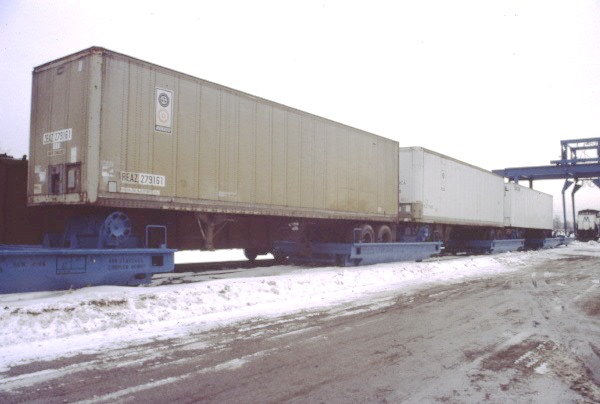
What the bogies look like when loaded with trailers. Photo by Albert Castelli c/o Steve Lynch’s excellent LIRR history site.
The MTA is planning on removing these blue cars at some point. It’s not clear how they will do this, as the track they are parked on is currently cut off at either end (this track is severed across M drawbridge, and the switch by Thomson Avenue is ripped out). I’m hoping at least one or two get preserved, either in any potential new park on these tracks, or at the Railroad Museum of Long Island in Riverhead. They can make for great conversation pieces on experimentation, the limitations to moving freight on Long Island, and NYC’s unusually high dependency on trucks to move goods. While the bogies proved to be a failed experiment, it would be great if further experimental means of moving containers were tried out. I’ve heard of one little documented test train that Conrail and LIRR ran in the early 1990s using a different type of rail car that apparently ran without incident. If we put a man on the moon, I’m sure we can find a way to address today’s ridiculously understated need to remove NYC’s reliance on trucks – either via improved railcar technology, investment in new ‘carfloat’ barges, or additional new transloading facilities. Rail freight in NYC and Long Island has made vast strides in removing trucks from our regions roads in the last 20 years, but there’s significant work yet to be done.
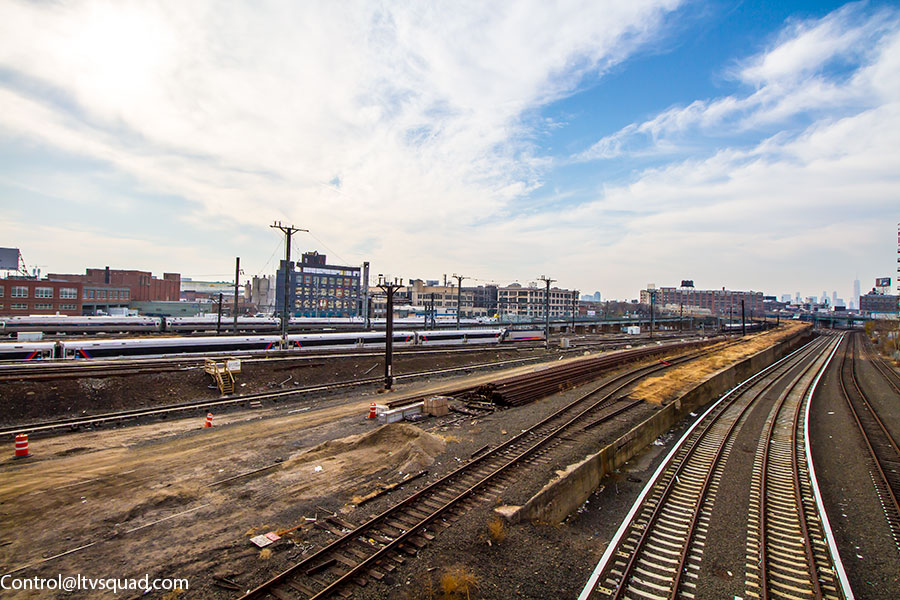
The northwest end of the Montauk cutoff as seen at Thomson avenue – the cutoff is the set of tracks rising left to right on a concrete ramp. Note that the track on the right, leading to the bogies, has its switch severed
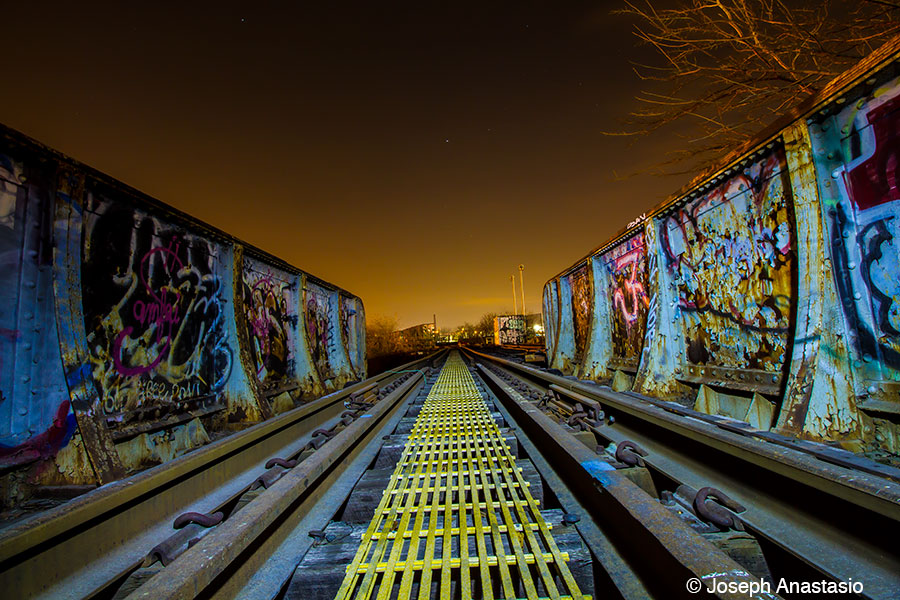
M cabin drawbridge. You can see trash cars parked for Waste Management just on the other side.

Looking northeast up Dutch Kills.
What comes next?
While it is safe to say no trains will use the montauk cutoff anytime in the next 5-10 years (A guess based off MTA’s budgeting process), we are pleased that the MTA is not selling off the real estate, and has made no secret that it may be needed for rail again in the future. The likelihood of this need is something transit advocates debate. In a city expected to reach a population of 9 Million in coming years, there’s clearly a need for better transit (and much of Queens has horrible commute times) and this short stretch of track might provide a much needed right of way someday – though the MTA is chronically under-funded and in no current position to create a new commuter rail route here. (NYC has a bad track record with these things – the Second Avenue Subway was first proposed in 1929 and is nowhere near complete today).
With the current real estate market and insane pace of residential construction in LIC, the likelihood of another freight customer ever being located north of the cutoff is basically zero. Manufacturing costs in NYC are simply too high.
The MTA’s refusal to sell the right of way should scare away most large real estate developers, and allow the cutoff to be used by community based organizations for recreational, cultural and educational use in the immediate years to come. In a city becoming more and more devoid of such spaces, I do hope something great becomes of this space.
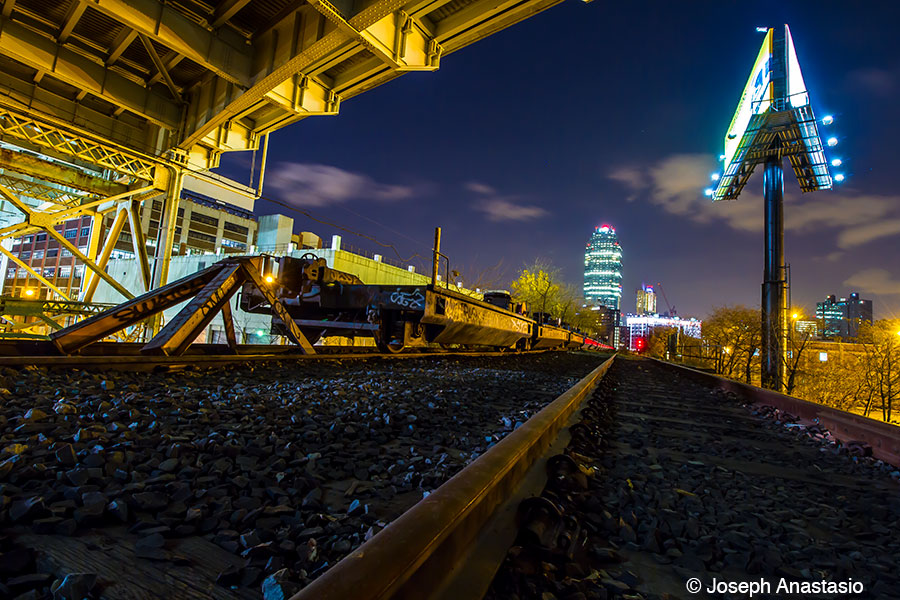
New camera? These shots are incredibly better than usual, and the website has had a nice reboot as well
Thanks – same ole camera, though a lot of these were shot with a better lens.
How would you get there? Me & some friends have been exploring places like the Wayne Manor and Batcave (Photos can be seen on my instagram @PresidentAlford;@Jello.bodega) Any info would be helpful.
Thanks in advance.
There is bad news. Apparently it is scheduled to be demolished as part of ESA.https://www.flickr.com/photos/127872292@N06/33906213010/in/dateposted-family/
4/20/2018
https://www.youtube.com/watch?v=iLw-rJOd00o
@13:21 in the video, it looks like MTA is tearing down the Montauk Cut-off.
Indeed, they have removed the ramp up from the freight yard and I presume will be taking down the curved overpass tracks this year.
This portion of the viaduct is directly above all tunnel entrances, and crumbling, so they are keen to get it out of there before disaster strikes.